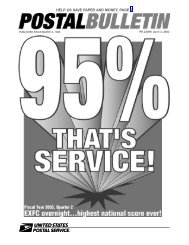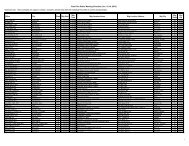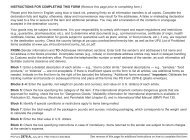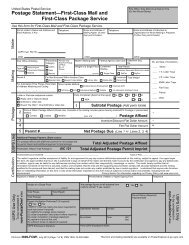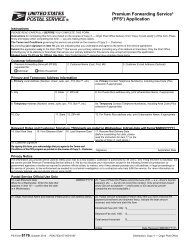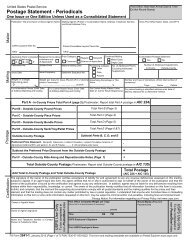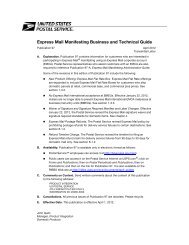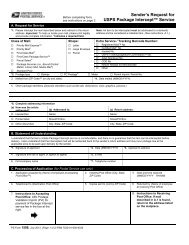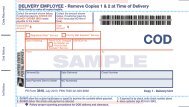Postal Bulletin 22144 - December 23, 2004 - USPS.com
Postal Bulletin 22144 - December 23, 2004 - USPS.com
Postal Bulletin 22144 - December 23, 2004 - USPS.com
You also want an ePaper? Increase the reach of your titles
YUMPU automatically turns print PDFs into web optimized ePapers that Google loves.
POSTAL BULLETIN <strong>22144</strong> (12-<strong>23</strong>-04)<br />
65<br />
Employees (Continued)<br />
Handbook EL-803, Maintenance Employee’s<br />
Guide to Safety<br />
SECTION XI<br />
* * * * *<br />
In-Plant Powered Industrial Trucks<br />
[Revise Section XI to read as follows:]<br />
This section applies to all types of materials-handling<br />
equipment <strong>com</strong>monly known as powered industrial trucks<br />
(PITs), as described in OSHA Standard 1910.178 — such<br />
as tow motors, fork trucks, tractors, platform lift trucks, motorized<br />
hand trucks and other specialized industrial trucks<br />
powered by electric motors or internal <strong>com</strong>bustion engines.<br />
Fuel-powered industrial trucks are generally prohibited indoors.<br />
Consult with your local safety professional before<br />
using a fuel-powered industrial truck.<br />
You must be trained and authorized to operate in-plant<br />
powered industrial trucks. PIT operators are responsible for<br />
ensuring vehicle safety and following all safety requirements.<br />
Immediately report to your supervisor all PIT-related<br />
accidents and near misses, including property damage;<br />
they must be investigated and reported on a Form 1769.<br />
A. Vehicle Regulations<br />
Inspect brakes, steering apparatus, horn, etc., each<br />
day prior to using in-plant powered industrial trucks.<br />
Tag all defective powered industrial trucks using<br />
Form 4707, remove them from service, and report all<br />
defects to your supervisor immediately.<br />
Be sure that all in-plant powered industrial trucks are<br />
equipped with horns and a flashing warning light that<br />
works.<br />
Do not operate industrial lift trucks with the overhead<br />
guard or load backrest removed.<br />
B. Driving Regulations<br />
1. Do not operate powered industrial trucks in a reckless<br />
manner; this is strictly prohibited.<br />
2. Use a hard hat under these situations:<br />
When working above floor level.<br />
When working from mechanical lifts and<br />
platforms.<br />
When operating powered mechanical equipment<br />
and where an overhead hazard exists.<br />
When local safety rules are based upon a hazard<br />
assessment requiring hard hat protection.<br />
3. Do not ride with any part of the body protruding from<br />
the powered industrial truck.<br />
4. Use only the designated truck traffic aisles.<br />
5. Make sure there is adequate clearance before proceeding<br />
under all overhead obstructions.<br />
6. Face the direction toward which you are moving and<br />
be careful of rear-end swing when turning corners.<br />
7. Speed<br />
Drive in-plant powered industrial trucks below 5<br />
mph (that is, about the speed of a fast walk).<br />
Approach all intersecting aisles and towveyor<br />
crossings slowly and cautiously. Sound the horn<br />
to inform pedestrians of your approach.<br />
Keep the powered industrial truck at least three<br />
vehicle lengths behind other vehicles when<br />
traveling.<br />
8. Backing Up<br />
Check to be certain there is a clear path to the rear<br />
before backing.<br />
Do not back powered industrial trucks through<br />
doorways, unless your field of vision is clear.<br />
9. Passengers<br />
Never exceed powered industrial truck seating<br />
capacity.<br />
Provide securely attached seating for passengers.<br />
Never allow a passenger to ride on an in-plant<br />
powered industrial truck without securely attached<br />
seating.<br />
10. Industrial Lift Trucks<br />
Use industrial lift trucks only for lifting and hauling<br />
loads. Do not use them as a means of personal<br />
transportation or for raising personnel to elevated<br />
locations, unless properly equipped and installed<br />
personnel platforms are used.<br />
Lift, lower, and carry loads with industrial lift trucks<br />
with the lifting mechanism vertical or tilted back,<br />
but never tilted forward.<br />
Keep forks on a moving lift truck low (just high<br />
enough to clear all floors and low enough to clear<br />
all overhead obstructions). Under normal conditions,<br />
3 inches above floor level should be<br />
sufficient.<br />
When approaching or leaving a building where the<br />
ramp incline is greater than 10 degrees, turn the



